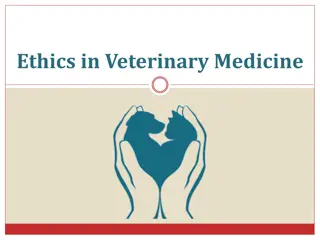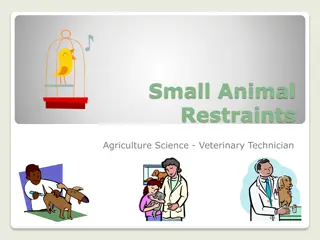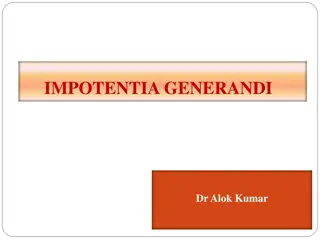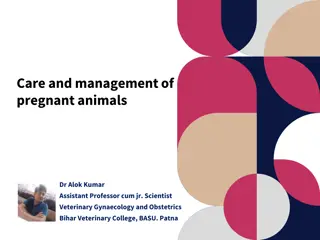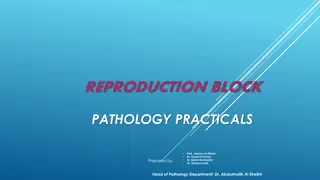Understanding Testis Disorders in Small Animals: A Veterinary Perspective
Explore various testis disorders such as anorchism, monorchism, cryptorchidism, orchitis, and epididymitis in small animals. Learn about the causes, diagnostic methods, and complications associated with these conditions. Gain insights into the importance of early detection and proper management for the well-being of your furry companions.
Download Presentation

Please find below an Image/Link to download the presentation.
The content on the website is provided AS IS for your information and personal use only. It may not be sold, licensed, or shared on other websites without obtaining consent from the author. Download presentation by click this link. If you encounter any issues during the download, it is possible that the publisher has removed the file from their server.
E N D
Presentation Transcript
Testis disorders Testis disorders Dr.AlaaA. Ibrahim University of Basrah \College of Veterinary Medicine Department of Veterinary Surgery and Obstitric
Disorders of the testes Anorchismis the absence of both testicles. This condition is rare in small animals Monorchismis the absence of one testicle. This condition is rare in small animals Definitive diagnosis is obtained by careful ultrasonographic evaluation, computed tomography, magnetic resonance imaging, or exploratory abdominal surgery. Disorders of the testes
Cryptorchidism Cryptorchidismis a condition in which one or both testicles do not descend into the scrotum The testis originates on the caudal ridge of the kidney in the abdominal cavity of the fetus, passes through the inguinal canal, and descends into the scrotal cavity. Testicular descent into the scrotum depends on the growth and action of the gubernaculum
Cryptorchidismis described by location (abdominal, inguinal, prescrotal), side (right, left), and number of testicles affected (unilateral, bilateral). In dogs and cats, unilateral cryptorchidism is more common than bilateral cryptorchidism Bilateral cryptorchid patients are sterile because of thermal uppressionof spermatogenesis; however, testosterone is still present and allows normal development of secondary sex characteristics, such as feline penile barbs Neoplastic transformation or testicular torsion in dogs are additional complications of cryptorchidism
Orchitisand Epididymitis Primary causes of orchitisand epididymitis include:- Infectious causes such as bacterial (Brucellacanis, Klebsiellaspp.), viral (canine distemper), fungal (Rhodotorulaglutinis), or rickettsial (Rocky Mountain spotted fever) infection Secondary causes include trauma to the testicle or epididymis, which can result in secondary inflammation or infection, and ascending infection from the prostate or urinary tract Primary orchitisand epididymitis must be carefully differentiated from testicular neoplasia and torsion, which have similar clinical signs Signs include swelling, pain, lethargy, inappetence, vomiting, pyrexia, and a stiff walking gait
Testicular Torsion Testicular Torsion Rare condition in small animals Torsion of a testicle is more often associated with an intra-abdominal testicle, possibly because it is more mobile; however, inguinal and scrotal testicular torsions have been reported
Patients affected with testicular torsion can present with vague clinical signs (e.g., anorexia, vomiting, lethargy) or signs typical of an acute abdomen, such as mild to marked abdominal discomfort and shock. Testicular torsion is an emergency situation and without fast diagnosis lead to death Diagnostics include abdominal radiography, abdominal ultrasonography, and abdominal exploratory surgery. A palpable intra-abdominal mass may also be found during physical examination
Testicular Neoplasia Common primary testicular neoplasms include interstitial cell (Leydig) tumors, Sertoli(sustentacular) cell tumors, and seminomas The mean age of affected dogs range, 3 to 19 years. Feline testicular tumors are rare, and it is unknown if feline cryptorchid testicles are prone to developing neoplasia
STERILIZATION Orchiectomy (surgical removal of the testicles). Castration refers to removal of either the male or female sex organs, but it is most commonly used interchangeably for orchiectomy Indications 1-reduce overpopulation by inhibiting male fertility and decrease undesirable urination behavior. 2-it helps prevent androgen-releateddisease, including prostatic diseases, perineal adenomas, and perineal hernia. 3-congenital abnormalities testicular or epididymalabnormalities, scrotal neoplasia, trauma or abscesses.
Nonsurgical Sterilization Techniques Nonsurgical methods of sterilization in cats and dogs include injections with testosterone and luteinizing hormone releasing hormone agonist, chlorhexidine digluconate, gonadotropin releasing hormone, glycerol, or zinc gluconate These techniques can induce azoospermiawithout inhibiting the development of sexual characteristics The most common method of nonsurgical chemical sterilization is zinc gluconate testicular injection The volume injected is based on caliper measurement of the testicle and varies between 0.2 and 1.0 mL/testicle
All methods of chemical sterilization have inconsistent long-term efficacy and can result in adverse side effects such as pain, inflammation, infection, scrotal ulcers or necrosis, scrotal and preputial draining tracts, and testicular necrosis. Treated animals may have sperm up to 60 days after injection, and some fail to achieve azoospermiaand therefore require retreatment. Because testosterone is still present, associated behaviors and disease conditions such as perineal hernias, perianal adenomas, and Benign prostatic hyperplasia (BPH) are not eliminated
SURGICAL TECHNIQUES(Canine Orchiectomy) Can be performed with an open or closed technique. Closed technique, the parietal vaginal tunic is left intact. Open technique, the parietal vaginal tunic is incised, penetrating the potential peritoneal space below. In both techniques, scrotal ablation is usually not required because the scrotum will usually regress sufficiently.
The scrotum in dogs is thin, pigmented, and covered with finely scattered hairs while in cats is densely haired It composed of three layers: the skin, tunica dartos, and scrotal fascia. The tunica dartos is a poorly developed layer of smooth muscle mixed with collagenous and elastic fibers that lies deep to the skin. The testes are able to be drawn closer to the body when the tunica dartos contracts The scrotum is divided into two cavities by a median septum composed of fascia and tunica dartos Within each scrotal sac is an evaginatedpouch of peritoneum called the vaginal process, which is covered by the external and internal spermatic fascia. The external pudendal artery is the principal blood vessel to the scrotum
Castration technique In both open and closed castration techniques, The canine patient is placed in ventral recumbency The prescrotal area is clipped and surgically prepared; the scrotum is not shaved to avoid scrotal irritation Long scrotal hairs can be cut short The scrotum can be moistened with antiseptic solution before draping to keep hairs away from the prescrotal region
Both the open and closed techniques use a midline prescrotal incision, with care taken to not extend the caudal part of the incision onto the scrotum Pressure is applied through the drape to the scrotum to push the testicle cranially
A prescrotal skin incision is made directly over the testicle to avoid inadvertent iatrogenic urethra damage The subcutaneous tissue and spermatic fascia are sharply incised over the testis to expose the parietal vaginal tunic. The testis can then be exteriorized Scrotal fat and fascia are stripped from the parietal vaginal tunic with a gauze sponge to provide maximal testicle exteriorization
Fat and spermatic fascia are stripped from the spermatic cord.
After two ligatures have been placed (as described in text), the spermatic cord is cut between clamps.
Before releasing the clamp, the stump is grasped with thumb forceps
Open prescrotal castration Incise the parietal vaginal tunic over the testicle Do not incise the tunica albuginea because this would expose the testicular parenchyma Place a hemostat across the vaginal tunic where it attaches to the epididymis. . Digitally separate the ligament of the tail of the epididymis from the tunic while applying traction with the hemostat on the tunic Further exteriorize the testicle by applying caudal and outward traction. Identify the structures of the spermatic cord. Individually ligate the vascular cord and ductus deferens, then place an encircling ligature around both. Many surgeons ligate the ductus deferens and pampiniform plexus together
Use 2-0 or 3-0 absorbable suture (e.g., polyglactin 910 [Vicryl], polydioxanone [PDS], poliglecaprone 25 [Monocryl], polyglyconate [Maxon], or glycomer 631 [Biosyn]) for ligatures Advance the second testicle into the incision, incise the fascial covering, and remove the testicle as described Appose the incised dense fascia on either side of the penis with interrupted or continuous sutures. Close subcutaneous tissue with a continuous pattern. Appose skin with an intradermal, subcuticular, or simple interrupted suture pattern.
Open castration The parietal vaginal tunic is incised over the testicle
Open castration Open castration Metzenbaumscissors are used to extend the incision through the parietal vaginal tunic
Open castration The incision has been extended through the parietal vaginal tunic.
Open castration The parietal tunic, cremaster muscle, and ductusdeferens and its vessels are separated from the spermatic vascular cord (testicular artery, nerve, and pampiniformplexus). Clamps are applied to each section
Feline Orchiectomy Cats can be positioned in dorsal or lateral recumbency with the hindlimbs pulled forward. The hair over the scrotal sac is plucked free of hair Feline Orchiectomy
Feline Orchiectomy The scrotum is draped within the surgical field. The testicle is immobilized within the scrotum, and the overlying skin is incised. The incision should be parallel to the scrotal median septum and about half the distance from the septum and the lateral aspect of the scrotum Feline Orchiectomy
Feline Orchiectomy The testis is pushed through the scrotal incision Testicle is being exteriorized For prepubertalcastrations, the spermatic cord should be pulled cautiously because it cannot be exteriorized as far and may be more fragile Cord ligation is performed with an overhand hemostat technique, figure of eight hemostat technique, suture or hemoclipattenuation or square knot open technique The cord is transected 2 to 6 mm distal to the ligation site and evaluated for hemorrhage
Feline Orchiectomy The remaining testicle is approached through a second skin incision, and the process is repeated. Scrotal skin incisions are left open to heal by second intention Ideally, patients should have their activity restricted for 3 to 7 days, and an Elizabethan collar should be placed on patients interested in licking their incisions. Analgesics such as NSAIDs and opioid or opioid-like (tramadol) drugs should be prescribed
FelineSpermatic cord ligation techniques 1. 1. Overhand Hemostat and Figure of Eight Hemostat Overhand and figure of eight techniques are performed with Halsted mosquito hemostatic forceps Some veterinarians believe that the figure of eight knot is more secure than the overhand knot; however, it may be more difficult to slide the knot over the hemostat. For both techniques, the spermatic cord Overhand Hemostat and Figure of Eight Hemostat Techniques: Techniques:- -
Overhand Hemostat and Figure of Eight Hemostat Techniques For both techniques, the spermatic cord should be wrapped around the hemostat close to the tips and to the scrotum Before hemostat release, the knot is tightened by placing traction between the knot and the hemostat Overhand Hemostat and Figure of Eight Hemostat Techniques
2- Ligation Technique Ligation Technique Two circumferential ligatures are placed around the distal spermatic cord using 3-0 or 4-0 monofilament absorbablesuture. A two-or three-clamp technique can be used if necessary. Alternatively, two appropriately sized hemoclipscan be placed on each spermatic cord.
3 3- - Square Square Knot Knot Technique Technique The square knot technique is an open castration The vaginal tunic, its associated cremaster muscle, and the ductusdeferens and its associated vessels are separated from the spermatic vascular cord (testicular artery, nerve, and pampiniformplexus) , resulting in two separate structures. These two structures are tied together with two or three square knots (four to six throws), and the spermatic cord is transected distally Failure of this technique occurs when slip knots are placed instead of square knots




